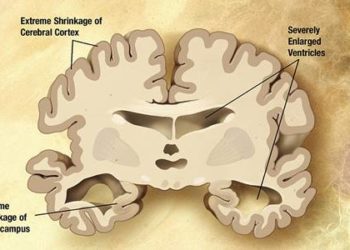Plasma p-tau217 is an accurate plasma biomarker of pathologic cerebral changes in patients with Down Syndrome
1. Plasma biomarkers, including p-tau217, were found to accurately detect cerebral changes pathognomonic for Alzheimer’s disease in this cross-sectional, multicenter study
2. Adults with Down Syndrome are at increased risk of developing Alzheimer’s disease due to over-expression of the APP
Level of Evidence Rating: 2 (Good)
Study Rundown: Down Syndrome is a genetic condition caused by a nondisjunction of chromosome 21 and presents with a range of clinical manifestations from the time of birth onwards. The APP gene is frequently overexpressed in Down Syndrome individuals and leads to an accumulation of tau protein in the brain as seen in Alzheimer’s disease. This may or may not cause a decline in function consistent with a clinical diagnosis of dementia, although the neuropathologic changes are the same. The present study sought to identify plasma biomarkers to aid in the diagnosis and prognostication of Alzheimer’s disease in patients with Down Syndrome.
In total, 300 participants with Down Syndrome (DS) and 37 of their siblings (controls) were included in this study. 212 patients were cognitively stable at baseline, 40 had mild cognitive impairment and 33 had Alzheimer’s dementia. DS patients began to develop AB-PET changes on imaging at around 35 years of age. P-tau217, GFAP and NfL plasma biomarkers were increased in the DS group as compared to non-DS siblings and titers correlated with the severity of cognitive impairment. Higher levels of tau protein in the serum were also associated with poor cognitive function as measured by the Down Syndrome mental status exam and cued recall testing.
Janelidze et al conclude that p-tau217 in the plasma is associated with cerebral tau and AB protein levels and is thus an accurate marker of Alzheimer’s disease in patients with Down Syndrome. A primary limitation of this study is the cross-sectional format which prohibits longitudinal data collection. Additionally, the clinical applicability of these findings is limited due to the practical and financial limitations of the biochemical tests performed in this study. However, this work is novel and may open new avenues for research and clinical practice in the future.
Click here to read this study in JAMA Neurology
Relevant Reading: Assessing candidate serum biomarkers for Alzheimer’s disease: a longitudinal study
In Depth: [cross-sectional study]: This cross-sectional, multi-center study, the Alzheimer’s Biomarker Consortium Down Syndrome (ABC-DS) study, enrolled participants between July 2016 and January 2019. At the time of enrollment, cognitive status was assessed as stable, mildly impaired or severely impaired (dementia) using standard clinical measurement tools. The following plasma biomarkers were assessed using immunoassay technologies previously described in the literature: p-tau217, GFAP, NfL and t-tau proteins. Additionally, PET imaging was used to assess uptake of TAU and AB proteins which correlate with structural cerebral changes.
The tau-PET signal was most prominent in the temporal region of interest on imaging amongst individuals with p-tau217 detected in the serum. The odds ratio and 95% confidence interval for each serum biomarker with temporal tau-PET activities are as follows: 2.13 (1.52-2.99) for p-tau217, 2.08 (1.49-2.89) for GFAP, 1.29 (1.06-1.57) for NfL, 1.24 (0.93-1.65) for t-tau and 1.15 (0.85-1.56) for AB42/AB40. Higher levels of plasma tau217 was associated with lower cognitive function on mental status exam (beta of -0.31, 95% confidence interval -0.40 to -0.22) and cued recall (-0.50, -0.60 to -0.40). Finally, sensitivity analysis stratifying patients by age (below 35 years) showed similar patterns of findings, although cerebral AB and tau protein load were less significant in younger patients compared to the older group.
Image: PD
©2022 2 Minute Medicine, Inc. All rights reserved. No works may be reproduced without expressed written consent from 2 Minute Medicine, Inc. Inquire about licensing here. No article should be construed as medical advice and is not intended as such by the authors or by 2 Minute Medicine, Inc.







